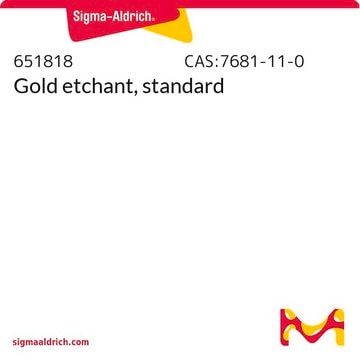643254
Goldbeschichtete Glasabdeckfolie
99.999% (Au), layer thickness 100 Å, L × W × thickness 22 mm × 22 mm × 130-170 μm, square
About This Item
Empfohlene Produkte
Assay
99.99% (Ti)
99.999% (Au)
L × B × Dicke
22 mm × 22 mm × 130-170 μm, square
Schichtdicke
100 Å
Brechungsindex
n20/587 1.523
Matrixanbindung
Titanium, as adhesion layer used to bind the gold to the borosilicate glass cover slip
SMILES String
[Au]
InChI
1S/Au
InChIKey
PCHJSUWPFVWCPO-UHFFFAOYSA-N
Suchen Sie nach ähnlichen Produkten? Aufrufen Leitfaden zum Produktvergleich
Verwandte Kategorien
Leistungsmerkmale und Vorteile
Sonstige Hinweise
Rechtliche Hinweise
Lagerklassenschlüssel
13 - Non Combustible Solids
WGK
nwg
Flammpunkt (°F)
Not applicable
Flammpunkt (°C)
Not applicable
Analysenzertifikate (COA)
Suchen Sie nach Analysenzertifikate (COA), indem Sie die Lot-/Chargennummer des Produkts eingeben. Lot- und Chargennummern sind auf dem Produktetikett hinter den Wörtern ‘Lot’ oder ‘Batch’ (Lot oder Charge) zu finden.
Besitzen Sie dieses Produkt bereits?
In der Dokumentenbibliothek finden Sie die Dokumentation zu den Produkten, die Sie kürzlich erworben haben.
Kunden haben sich ebenfalls angesehen
Unser Team von Wissenschaftlern verfügt über Erfahrung in allen Forschungsbereichen einschließlich Life Science, Materialwissenschaften, chemischer Synthese, Chromatographie, Analytik und vielen mehr..
Setzen Sie sich mit dem technischen Dienst in Verbindung.








